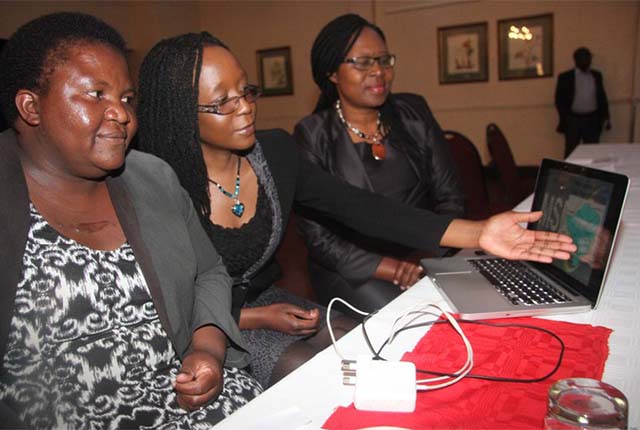‘We must always plan for drought’


Meteorological Services Department principal meteorologist Ms Vimbai Mamombe (centre) takes the department‘s deputy director (agro meteorology) Mrs Rebecca Manzou (right) and AGRITEX principal agronomist Ms Sibongile Chikore (left) the seasonal forecast for 2016-17 in Harare recently
The Interview with Tichaona Zindoga
TZ: The forecast for the 2016-17 rainfall season is out. Can you highlight for us the distribution and patterns for this term by regions?VM: The period from October to December termed OND is expected to have rainfall which is in the normal to above normal category across the whole country. For example, when an area has a climatological average rainfall of 248mm during OND, it is expected to receive that amount of rainfall or more. The JFM (January-March) season is expected to deteriorate in terms of rainfall over meteorological Region 3, while Regions 1 and 2 are forecast to be within the normal category with a bias towards the above normal.
There is a high likelihood of an early start of the season for the whole country, with significant rains as early as late September 2016 in the southern areas of the Zimbabwe. Inputs, including small grains, should be distributed to all regions (a) by the end of September 2016 in Matabeleland South, Masvingo, Midlands and southern districts of Manicaland and (b) by the end of October for the rest of the country.
In view of the moisture availability and suitable temperature thresholds, those with water should not wait for the main rains to fall. They can plant any time now. Despite the high chances of higher than usual rains this season, in terms of national strategic planning and development, Zimbabwe should always expect, and plan for, one form of drought or another.
It is now extremely rare for the whole country to experience the same weather conditions. There is need to continue with water harvesting programmes already underway, especially those in agro-ecological zones IV and V.
We should keep in mind that there are indications of deterioration in the rainfall amounts as the season progresses. The policies of small dam construction and borehole drilling/deepening, conservation and protection of wetlands should continue, more so in the southern provinces of the country.
Application of fertilisers should be guided by the 10-day weather forecasts as well as advice from agricultural authorities (conservation, e.g. contouring and ridging/smart agriculture). The 10-day weather forecasts will be issued from October until April.
It is also critical that incentives for maize production in support for Command Agriculture should be announced as soon as possible, rather than wait until the middle of the season.
TZ: And the issue of draught power is also a concern . . .
VM: Yes, mindful that many communal farmers lost cattle (hence stifling animal-drawn ploughing capability) during the recently ended drought, there is need to allocate some tractors and associated implements to them. After all, the bulk of the crop that goes to the GMB comes from small-scale farmers.
In terms of planting dates, as alluded above, farmers should consult with their local Agritex officers and also consider the three- to 10-day weather forecasts.
TZ: The traditional advice has been for people to use the first rains, but as we saw from last season a good number of farmers across the country had to plant again with rains that fell after a dry spell. How should people read and prepare for this year?
VM: Farmers should consult with their local Agritex officers and also consider the three- to 10-day weather forecasts.
TZ: There have some reports that Southern Africa is facing floods this term, what is the position and is Zimbabwe ready to deal with them?
VM: At the moment we cannot give information pertaining to flooding. However, in the case of flood occurrence during the season, the Department of Civil Protection (DCP) will advise accordingly.
TZ: What is your assessment of Zimbabwe’s adaptation to climate change and what should it do, especially around the issue of taming the weather and ensuring food security?
VM: The issue of adaptation to climate change is being handled by the Department of Climate Change Management. Also other Government departments that are vulnerable to climate variability and change such as water, energy, agriculture and food security, disaster risk reduction among others are also incorporating weather and climate into their policies and strategies.
The Meteorological Services Department is also working with some United Nations agencies in the country, NGOs, research institutes and the private sector in their quest to adapt to weather and climate change. We as a department are not in a position to assess how far they have gone in their actions on adaptation.
Lastly we wish to advise that the emphasis is now on climate resilience as opposed to climate change. This is because climate change is mostly futuristic whereas climate resilience is about coping with current extremes in the weather and climate. Therefore, it is difficult to adequately adapt because the climate is changing and it will always change.








Comments